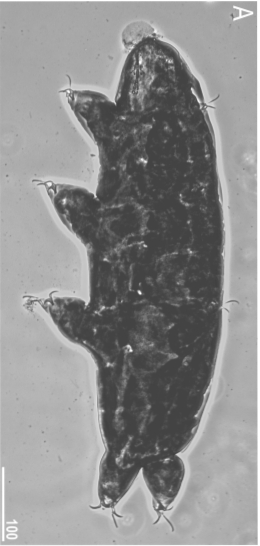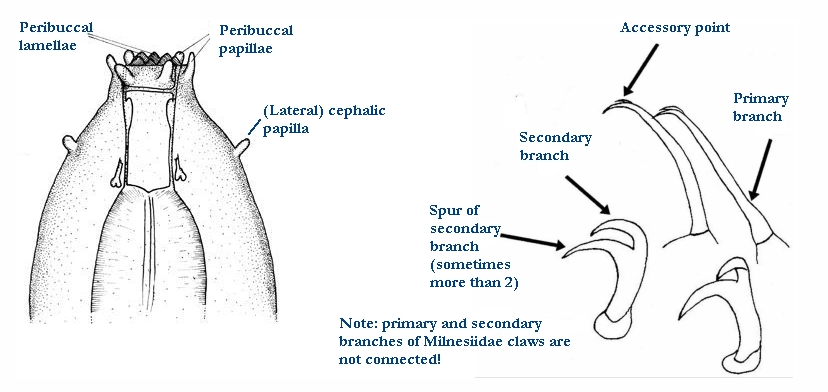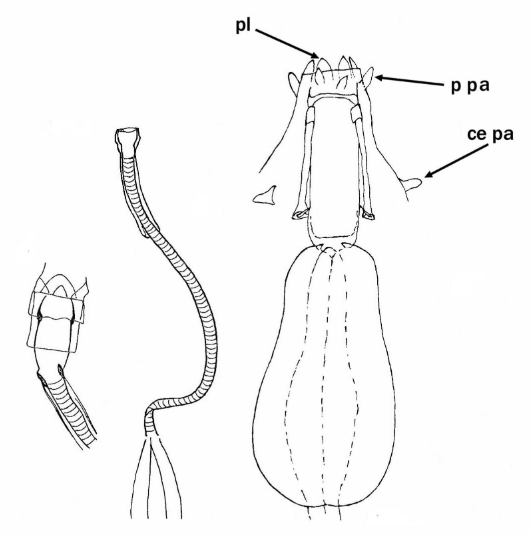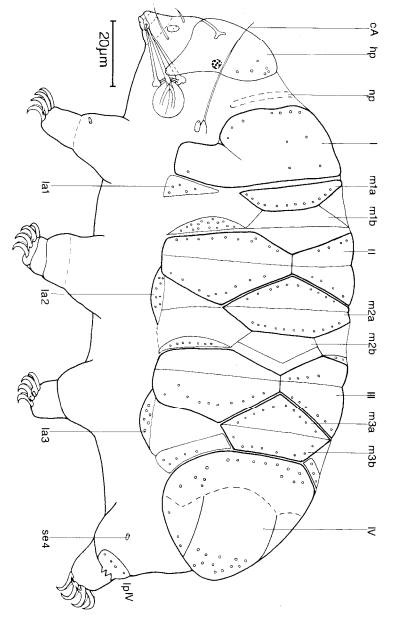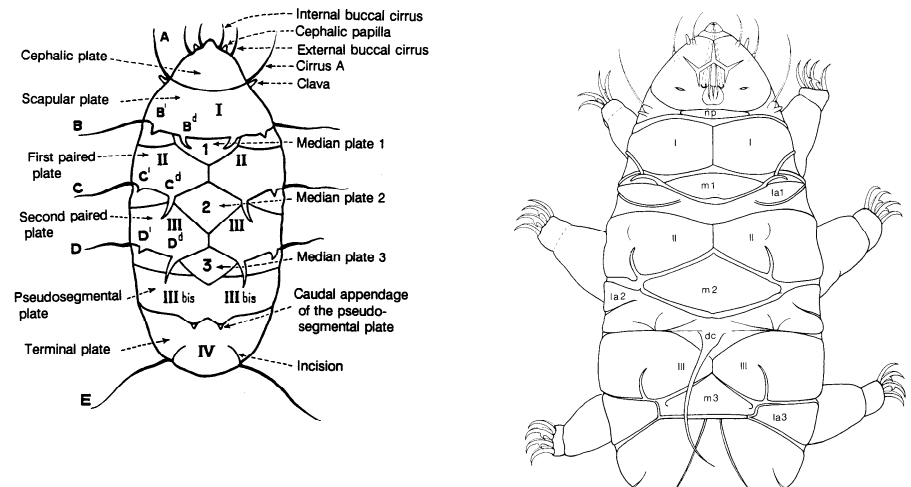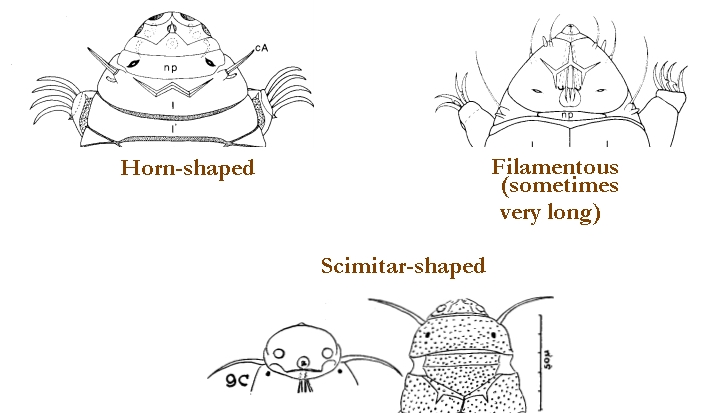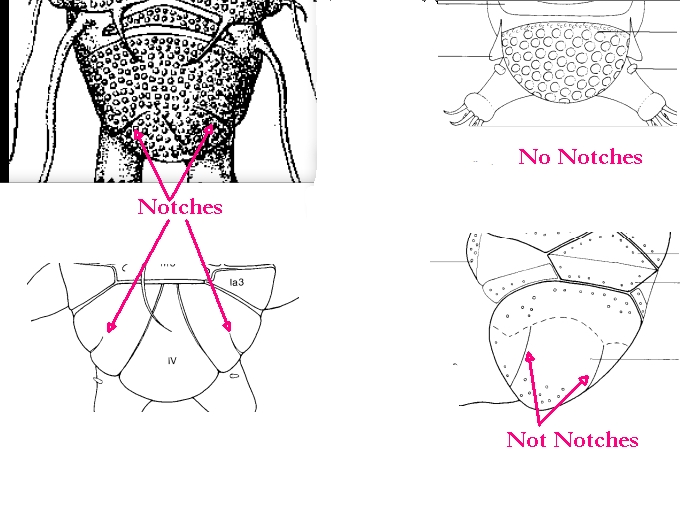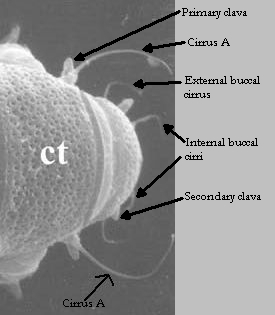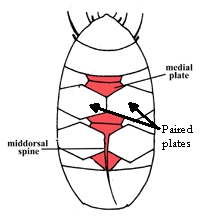Genus Thulinius
Isohypsibioidea from Marley et al. 2011: “Parachela. Claws asymmetrical (2121); Isohypsibius-type claw pairs; AISM ridged.”
Isohypsibioidea from Bertolani et al. 2014: “Double claws asymmetrical with respect to the median plane of the leg (2121), normally with similar shape and size on each leg; double claws of the Isohypsibius type (secondary branch of the external claw inserted perpendicularly on the claw basal tract), or reduced from it: Hexapodibius type (very short, without common basal tract, with a base as large as the sum of the primary and secondary branch widths, and with an evident suture between primary and secondary branch); Haplomacrobiotus type (one branch only); completely absent (Apodibius). Buccal tube completely rigid (apart Paradiphascon; see below) and often relatively large, without (Dastychius, Eremobiotus, Halobiotus, Isohypsibius, Paradiphascon, Pseudobiotus, Thulinius) or with (Apodibius, Doryphoribius, Haplomacrobiotus, Haplohexapodibius, Hexapodibius, Parhexapodibius) ventral lamina. Eggs with smooth shell laid within the exuvium.”
Isohypsibiidae from Marley et al. 2011: “Isohypsibioidea. Claw pairs of similar size and shape. External and internal claws exhibiting articulation (the basal section and secondary branch form a solid unit while the primary branch and secondary branch articulate). Claws Isohypsibius-type, forming a right-angle between basal section and secondary branch. AISM ridge-like.”
Genus description from Bertolani 2003: “Mouth opening with 12 small, partially fused peribuccal lamellae surrounded by six peribuccal lobes, sometimes subdivided into a larger number of irregular sublobes; crest-shaped apophyses for the insertion of the stylet muscles on the buccal tube, claws of Isohypsibius-type
Remarks. The three species are characterized by a buccal armature with a posterior band of fine teeth, followed by a line of bigger round teeth, instead of transverse mucrones, as in several other genera of Hypsibiidae, Macrobiotdae and Eohypsibiidae, and by rows of macroplacoids, whose curvatures resemble a Grecian urn. The species differ together mainly for the shape of the cuticular structures of the legs. Thulinius ruffoi differs from T. stephaniae in having thinner claws with longer tapering basal tract, lunules evident and a less prominent cuticular bar below the claws of the first three pair of legs (other than for a more slender body). Thulinius augusti differs from the other two species by the presence of a particularly long and thin basal tract of the claw, especially in the external one, from T. stephaniae also by a weaker cuticular bar below the claws of the first three pair of legs, and from T. ruffoi also by the absence of lunules. The subdivision of the lobes into sub-lobes is another possible difference between T. augusti and the other two species.”
Key from Kaczmarek, Bertolani, & Nędzyńska-Stygar, 2010: “The genus Thulinius has a very conserved
morphology and its members are extremely similar to
one another. Specimens of this genus should be very
carefully examined, especially with regard to the
presence or absence of lunules, which are sometimes
barely visible especially in specimens in poor
condition or in specimens with unsuitable
orientation.”
1 Lunules under claws present……………………………………………………………………………………………………………………….2
– Lunules under claws absent………………………………………………………………………………………………………………………..4
2Lunules present only under the external (I–III) and posterior claws (IV), cuticular bars under claws divided ………… ………………………………………………………………………………………………………………………………. T. saltursus comb. nov.
– Lunules present under all claws, cuticular bars under claws not divided……………………………………………………………3
3 Buccal tube and macroplacoids short (buccal tube 28.6 long, macroplacoids: I placoid—3.7 [12.9], II—2.9 [10.1], III—3.7 [12.9] long in specimen 326.0 long), total body length up to 550 ……………………………………………… T ruffoi
– Buccal tube and macroplacoids long (buccal tube 42.2 long, macroplacoids: I placoid—5.5 [13.0], II—3.6 [8.5], III—5.2 [12.3] long in specimen 293.0 long), total body length up to 407 ………………………………………………… T. itoi
4 Basal claw very long and thin, cuticular bar under claws thin and short, evident subdivided lobes around the mouth …………………………………………………………………………………………………………………………………………………. T. augusti
– Basal claw short and robust, cuticular bar under claws long and wide, absence of subdivided lobes around the mouth……………………………………………………………………………………………………………………………………. T. stephaniae
Citations :
Thulinius image from Kaczmarek Ł, Bertolani R, Nędzyńska-Stygar M. 2010. Thulinius saltursus comb. nov.: a new systematic position for Isohypsibius saltursus Schuster, Toftner & Grigarick, 1978 (Eutardigrada: Hypsibiidae) and a key for the genus Thulinius. Zootaxa. 2483: 58-64.
“Parts” image from Bertolani R. 2003. Thulinius, new generic name substituting for Thulinia Bertolani, 1981 (Tardigrada, Eutardigrada). Zootaxa. 314: 1-4.
Bertolani R, Guidetti R, Marchioro T, Altiero T, Rebecchi L, Cesari M. 2014. Phylogeny of Eutardigrada: New molecular data and their morphological support lead to the identification of new evolutionary lineages. Molecular Phylogenetics and Evolution. 76: 110-126.
Marley NJ, McInnes SJ, Sands CJ. 2011. Phylum Tardigrada: A re-evaluation of the Parachela. Zootaxa. 2819: 51-64.
